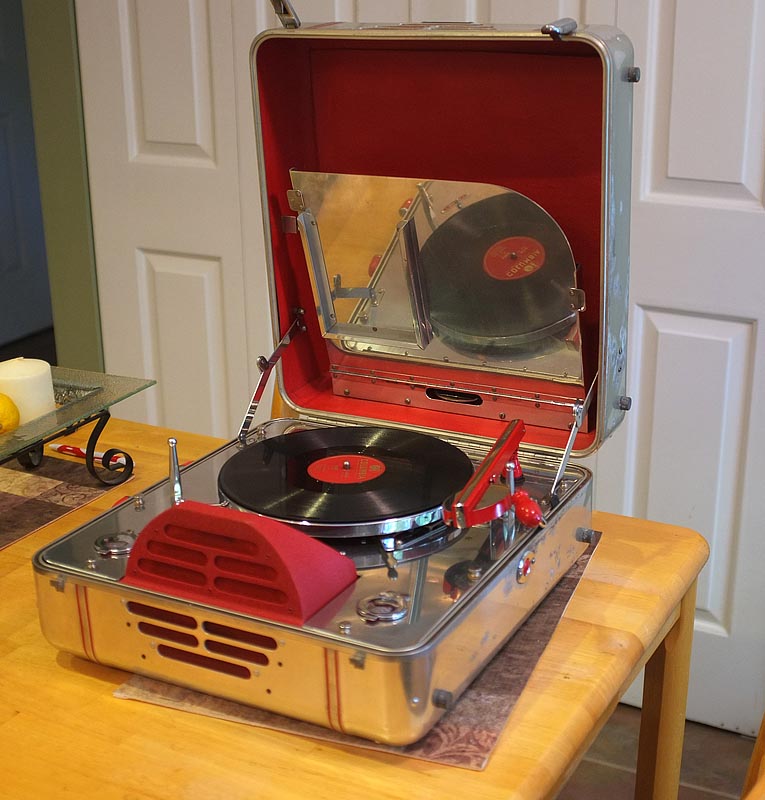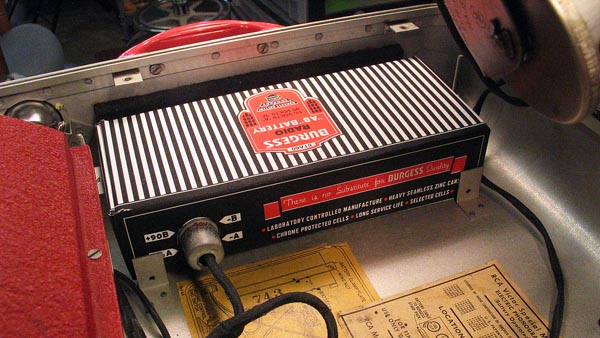RCA Victor Special Record Players
RCA Victor Special Model M circa 1938-1939
 In their book Phonographs With Flair: A Century of Style in Sound Reproduction, authors Timothy Fabrizio and George Paul suggest that the various RCA Victor Special Phonographs were produced to commemorate the 1939 World's Fair, held in New York City. RCA produced four models of this phonograph designed by industrial designer John Vassos. According to Cooper-Hewitt Smithsonian Design Museum, the mechanism was engineered and designed by Alfred Weiland and Seldon Williams. There's some conflicting information giving a 1935 date, but RCA sources indicate John Vassos began design work in 1937.
In their book Phonographs With Flair: A Century of Style in Sound Reproduction, authors Timothy Fabrizio and George Paul suggest that the various RCA Victor Special Phonographs were produced to commemorate the 1939 World's Fair, held in New York City. RCA produced four models of this phonograph designed by industrial designer John Vassos. According to Cooper-Hewitt Smithsonian Design Museum, the mechanism was engineered and designed by Alfred Weiland and Seldon Williams. There's some conflicting information giving a 1935 date, but RCA sources indicate John Vassos began design work in 1937.
Adding to the confusion, the American Tobacco Company provided each of their sales representatives with a Model M and special instructions. It is evident from the instructions that the machines were used to play recordings during sales calls to clients. Content of the recordings is unknown. Perhaps they were jingles used in radio adverstisements, celebrity endorsements, maybe even doctors touting the benefits of smoking.
Click the link to read or download the American Tobacco Company Model M Instructions to their sales force for operating the machines.
RCA apparently did not include these players in their product line literature, so very little is known about them. Models J and L came in a leather or leatherette covering. The Special Model J has a red leather like covering and the Special Model L has a green covering. The Special Model K and Special Modal M came in aluminum cabinets, with colored accents. Two Model Ks that I restored had black accents, and there are reports of a Model K with green accents. I have restored several Model M machines, and all have had red accents as shown here.
These gorgeous machines featured a two spring wind up motor and a three-tube battery powered amplifier, with input from a crystal cartridge that used a standard Victrola steel needle. As with the old acoustic Victrolas, a new needle is used for each record. The audio quality is quite good. A number of these can be found in museums, and they occasionally turn up on eBay. Be prepared to part with a couple large ones if you want to buy.
The machine shown at right belongs to a customer who needed a set of batteries and the amplifier restored. The owner had already restored the motor and installed a rebuilt phono cartridge.
I recapped the amplifier. Due to the rarity and value of this particlar machine, I installed the new capacitors inside the original capacitors to preserve the authenticity of the amplifier. I then built working batteries that I installed in original battery boxes provided by the owner. However, the amplifier still did not work.


With some research and help from the experts on the Antique Radio Forum, I was able to determine that an internal battery providing bias voltage to the second grid of the 1A6 tube was the problem. Replacing it with a 1M ohm resistor restored the amplifier to life.
Since then, I have worked on several more of these rare players. The one shown below, right, is very similar to the first player, and is also in very nice cosmetic condition. The owner wanted a working battery and the amplifier repaired.
 This particular machine used a Burgess 6AT60 AB battery instead of separate A and B batteries as the one shown above. I made a reproduction Burgess box and a working battery using ten 9-volt cells for the B power and three D cells in parallel for the A filament supply. See photo, left.
This particular machine used a Burgess 6AT60 AB battery instead of separate A and B batteries as the one shown above. I made a reproduction Burgess box and a working battery using ten 9-volt cells for the B power and three D cells in parallel for the A filament supply. See photo, left.
Like the first machine, this one also had the dead bias battery (see third photo, below). Isolating one lead to the dead battery and jumping the connections with a 1M ohm resistor fixes the problem. I also embedded the new capacitors in the original capacitors to preserve its original look.
At some point in its history, this player received a new Japanese crystal cartridge, probably around 1950-1960. Remarkably, this cartridge is still in excellent condition, and puts out a strong, clear signal. The photo below, left, shows an original, but rebuilt, Astatic crystal cartridge on the left, and the Japanese crystal cartridge on the right. This type of cartridge is no longer available.

You can hear both machines play at this You Tube link.
I have never found any documentation for these record players, and in order to diagnose the problem with the first unit I restored, I created a schematic diagram of the battery powered amplifier, which can be viewed here:
Schematic for the RCA Victor Special Model M
Back to Record Player & Audio Menu



 In their book Phonographs With Flair: A Century of Style in Sound Reproduction, authors Timothy Fabrizio and George Paul suggest that the various RCA Victor Special Phonographs were produced to commemorate the 1939 World's Fair, held in New York City. RCA produced four models of this phonograph designed by industrial designer John Vassos. According to Cooper-Hewitt Smithsonian Design Museum, the mechanism was engineered and designed by Alfred Weiland and Seldon Williams. There's some conflicting information giving a 1935 date, but RCA sources indicate John Vassos began design work in 1937.
In their book Phonographs With Flair: A Century of Style in Sound Reproduction, authors Timothy Fabrizio and George Paul suggest that the various RCA Victor Special Phonographs were produced to commemorate the 1939 World's Fair, held in New York City. RCA produced four models of this phonograph designed by industrial designer John Vassos. According to Cooper-Hewitt Smithsonian Design Museum, the mechanism was engineered and designed by Alfred Weiland and Seldon Williams. There's some conflicting information giving a 1935 date, but RCA sources indicate John Vassos began design work in 1937.

 This particular machine used a Burgess 6AT60 AB battery instead of separate A and B batteries as the one shown above. I made a reproduction Burgess box and a working battery using ten 9-volt cells for the B power and three D cells in parallel for the A filament supply. See photo, left.
This particular machine used a Burgess 6AT60 AB battery instead of separate A and B batteries as the one shown above. I made a reproduction Burgess box and a working battery using ten 9-volt cells for the B power and three D cells in parallel for the A filament supply. See photo, left.